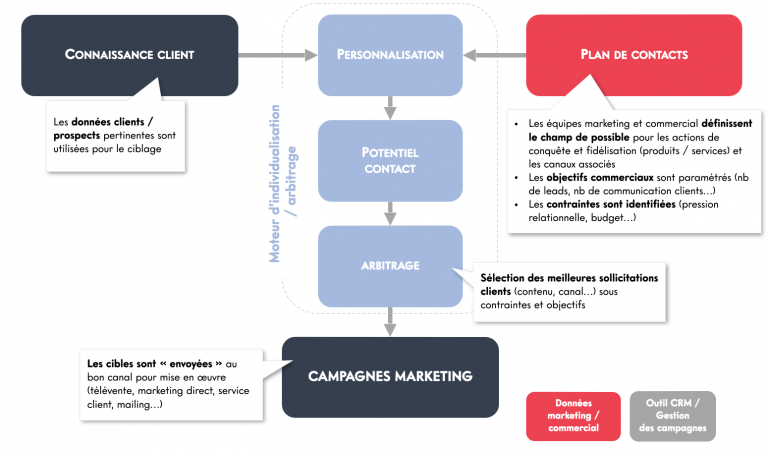To achieve sales objectives, lead management has become a key activity that needs to be closely monitored to guarantee economic equilibrium:
- Which marketing levers to use? At what cost?
- What customer pathways should you offer?
- How to optimize the conversion tunnel at every stage?
- How can you really manage acquisition costs?
On the basis of numerous assignments carried out on the subject, we have identified goodlead management practices based on 5 key stages:
Contents

Stage 1: ACQUISITION
The issues at stake
- Identify the most effective/qualified levers at the best cost
- Finding the right partners, especially for digital acquisition
- Integrate all levers in the same management tool with the same data model
Best practices
- Diversify lead acquisition channels (social media, Adwords, comparators, content marketing, SEO, partnerships, affiliation, display...) with a test & learn approach, in order to assess the quality of leads received and their level of maturity.
- Use internal channels as well, bringing in leads from all the company's departments and employees (detection by an employee in the field, a customer service department, a back-office department, etc.).
- Set up customer paths that encourage cross-sell and up-sell (bounces on digital spaces, bounces following the identification of life events, identification of churn risks, etc.).
- Develop a common data model for all acquisition sources, so that data can be easily managed and compared in the CRM.
Step 2: QUALIFY and PRIORITIZE
The issues at stake
- Directing leads to the right processing skills
- Prioritize leads according to acquisition potential and ease of conversion
- Optimize inventory management
Best practices
- Strike the right balance between simplifying the customer journey and collecting data to qualify the lead (in most cases, the priority is to collect the customer's contact details so as to be able to contact them and qualify their needs).
- Prioritize lead management by using automatic scoring to treat leads with a high chance of conversion first (scoring can take into account additional data such as lead origin, target product/service, channel used, prospect's path, responsiveness, etc.).
- Enhance lead qualification with external data to improve scoring (e.g. INSEE data, such as average income by geographical area).
Stage 3: DISTRIBUTION and PROCESSING
The issues at stake
- Improve conversion rates
- Optimize processes and processing times
- Qualifying the need for nurturing
Best practices
- Direct customers along the customer path to immediate exchange mechanisms and avoid disruptions (web to call, web to chat, etc.).
- Simplify the subscription process as much as possible (1-step sales)
- Implement a predictive recommendation engine (new offer, service, cross-sell / up-sell) accessible via all sales channels (web-based proposal, telephone advisor highlighting, etc.).
- Set up sales gas pedals (promotions, etc.)
- Analyze individual performance and propose customized training programs for teams
Step 4: NURTURING THE LEADS
The issues at stake
- Identify dropouts throughout the course and implement follow-up actions
- Keep less mature prospects engaged over the long term
- Managing multi-channel marketing pressure
Best practices
- Set up a automated, customized campaign plans (via a marketing automation) :
- multi-channel relaunch and retargeting campaigns (SMS, e-mail, call...),
- content marketing campaigns to create a long-term bond (advice...)
- Controlling relational pressure
- The aim is to move from a "campaign" vision to a "customer" vision: what is the most appropriate solicitation for the given context and objectives?
- The implementation of an individualization and arbitration engine makes it possible to develop the most relevant targets on a daily/weekly/monthly basis.
- Finally, in terms of messages, personalized content marketing campaigns can create a long-term link and bring value to the prospect: advice, tutorials, white papers...

Stage 5: PILOTAGE
Measure to optimize performance at every stage of the conversion tunnel
The issues at stake
- Reconstruct customer and cross-channel paths
- Identify the most efficient routes
- Manage acquisition budgets based on CTAs
- Have the most reliable sales forecasts possible
Best practices
- Trace acquisition data throughout processing
- Implement a consolidated view of acquisition costs by channel/customer journey
Focus on a few key KPIs
Lead management needs to be managed on several levels :
- Cross-functional indicators need to be defined and monitored for each campaign. Campaign performance can be measured, for example, by conversion rate, cost per contact, acquisition cost, amount/purchase basket, ROI...
- Specific indicators for each channel must also be measured: rejection rate, open rate, click rate on email, rate of completed contacts, sales arguments, quotes sent...
- In addition to campaign-by-campaign analyses, comparative analyses should be carried out to optimize acquisition processes and actions over time: between lead sources, between types of campaigns and channels activated, between transformation channels by transformation stage or customer segment, according to prospect characteristics to optimize scoring...
- Databases must be analyzed and monitored: analysis and improvement of data quality (rejection rates, wrong numbers, etc.), management of marketing pressure (attrition rates, etc.), etc.
Finally, effective management also involves reconciling the various channels to obtain a consolidated view of the prospect's journey. Web and inbound call paths, for example, can be reconciled thanks to "voice cookie" solutions, to be integrated into customer relations centers. How does it work? Internet users are presented with a unique, "individualized" telephone number. If they call this number, the company will be able to make the link between their online experience and their telephone conversation with the customer service department. Among other things, this system makes it possible to identify the most effective digital acquisition levers, carry out personalized digital retargeting after the call, and determine the origin of polluting or higher-value calls...
How can iQo help you?
iQo is a new player in the consulting whose mission is to "unleash collective genius to co-construct desirable futures".
Our firm offers a unique approach to co-construction with our customers ...
- We advocate the hybridization of skills and know-how
- We offer you small, agile teams (squads) that are sincerely committed to working alongside you, as an extension of your teams.
- We are "makers" and offer concrete, results-oriented solutions tailored to your specific needs.
...and committed: we are a company with a mission, ISO 14001 certified and B Corp certified certified, and have co-constructed 23 positive-impact commitments with our employees.
Our Marketing & Customer Experience is structured around 5 themes:
- Customer strategy
- Innovation customer experience
- Marketing & sales efficiency
- Customer relationship efficiency
- Customer-focused transformation.
Further information

How to develop Customer Culture in 4 steps?
Customer culture refers to the relationship between your employees and your customers. It represents the desire, shared by the entire company, to place the customer at the heart of all our activities.

How can you improve customer service?
Improving customer service has become essential for many companies, given the new uses and needs of their customers. What innovative initiatives are companies implementing

How do you build an effective customer experience strategy?
Asking the question of customer experience strategy means recognizing that taking customer experience into account has gradually spread throughout companies.

